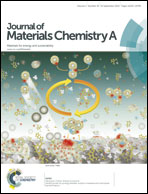A new strategy for co-assembling π-conjugated polymer/cadmium sulfide hybrids into an efficient charge-transporting nanochannel array by using an all-conjugated diblock copolymer motif†
Abstract
In this study, a novel organic/inorganic hybrid material containing cadmium sulfide (CdS) nanoparticles was synthesized in situ by using an all π-conjugated block copolymer as both a synergistic long-range ordered structure-directing template and an efficient exciton quencher for the nanohybrid. The conducting–conducting block copolymer of poly(2,5-dihexyloxy-para-phenylene)-b-poly(3-hexyl thiophene) (PPP-P3HT) was used as a linear nanoreactor for the quantum dot synthesis to yield nanohybrids with highly ordered donor/acceptor (D/A) nanowire morphology that exhibit enhanced optoelectronic properties. The synthesized PPP-P3HT/CdS-OH nanohybrid possessed a one-dimensional D/A coaxial nanowire structure of uniform width (∼10 nm), wherein the synthesized CdS quantum dots were embedded, resulting in a display of superior long-term stability in a solution medium. By a simple drop casting process, the hybrid materials with highly ordered organic/inorganic nanochannel arrays could also be preserved in a thin film state, as evidenced by TEM and X-ray measurements, for device applications. The PPP-P3HT block copolymer exhibited significantly better hole mobility than its P3HT homopolymer counterpart. In addition, the resulting PPP-P3HT/CdS-OH hybrid systems displayed a considerably enhanced PL quench effect and shorter exciton lifetime due to efficient charge transfer between the P3HT block and the confining CdS nanoparticles in the P3HT/CdS coaxial domain of the hybrid nanowire structure. Therefore, the PPP-P3HT/CdS-OH nanohybrids can be used as bicontinuous nanochannels for efficient charge separation and charge transport, which show potential for use in future optoelectronic applications.


 Please wait while we load your content...
Please wait while we load your content...